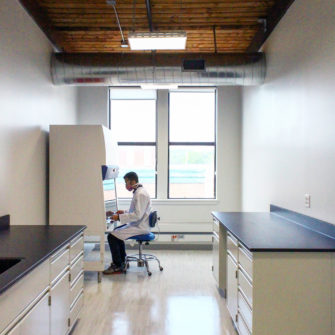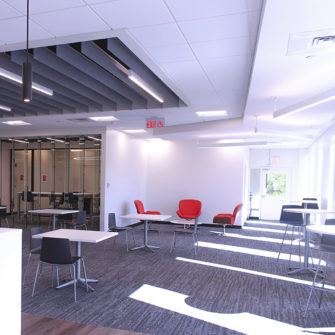Working with academic teams in designing successful renovations
Working with advisory groups is an essential component of designing in an academic environment. Not all committees are the same; different schools and even different renovations within a given department may have vastly divergent approaches to faculty involvement. The key to a successful renovation within these contexts is to be able to approach each mode with an open mind and an understanding of the dynamic inherent to each committee group type. In our practice, we have identified four types of groups and each has their strengths.
Faculty-Centered Team
In this advisory team, a select group of faculty members from the departments involved in the renovation serve on the design committee and relay the meeting results to the departments at large. The benefit of this approach is that a diverse faculty group tends to look at the design from the department as a whole, rather than the individual needs of single faculty member. Space allocation is looked at creatively and opportunities for shared resources are looked for. Identity and overall concept is easily discussed, as the focus is on the broader shared use of the project over a long term. Faculty are aware that they are bringing the results of the design sessions back to the rest of the faculty, which informs discussions and approaches.
Single End User
Occasionally, we find that we are tasked with redesigning a single lab or space for a faculty member. The team is selected around the faculty member, and might consist of one or two administrators, the end user and one of their graduate students. In this setting, the design is able to be tailored to a very specific use and need. Details are quickly arrived at and decision making tends to be swift. Often, the end user has a vision for the space and meetings center around drawing out this vision and testing how it might translate into architectural space. Input from the administrators helps maintain budget and schedule as well as program limits and opportunities.
Administration Based Team
In this group, faculty and others work under the leadership of a strong administrator to advise on the renovation. The faculty might be from the single department that has the renovation, or it might bring in other departments that have a stake in the project. Often, in this approach, university or college wide program elements are important components of the project, such as shared classroom space. This approach tends to have a broader focus, looking to be more future-forward and with a view to the wider campus needs.
Mixed Committee
Related to the faculty- centered team, this group has a broader makeup of equally empowered administrator, faculty, department heads, and faculty admin support. While this diverse of a group may take the most time to arrive at final solutions, it lends the broadest view and gives a say to more junior faculty and assistants. In this team, the college administrator looks at the overall project, both in terms of design and budget, guiding the group. In the best situation, department heads listen to and empower the junior faculty and department administrators to elicit design ideas and understand better how the department operates and how the design can improve the overall functionality of the project.
Conclusion
Key is to navigate these various groups to develop a cohesive design that builds on the program and manifests a vision for the project and the college as a whole. Understanding the dynamic and inherent focus of the advisory group in the early stages of the process is critical. Rather than taking suggestions at face value, mining for design intent and functional desire can lead to more creative solutions that solve the very real issues that the team brings to light during meetings. We have found that following through with questions when suggestions are offered leads to a broader and more informed understanding. Revisiting these questions throughout the design process allows the team to test their assumptions and needs against the evolving project. Often, early and quick assumptions by the group are replaced by more nuanced and complex formal decisions and a quick check back can both confirm that the new design is correct and can result in a confident buy-in from the group and thus from the department and college as a whole, leading to a successful project and and a happy client.
This article is adapted from a previously published article by Stephanie Goldberg in High Profile Monthly.

